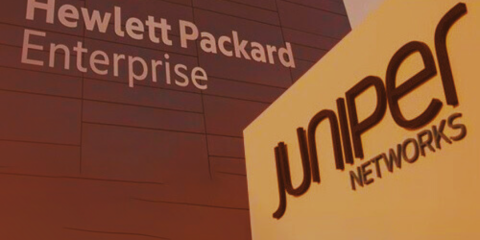Baran Baş
Introduction
The Turkish Competition Board (the “TCB” or the “Board”) approved the transaction concerning the acquisition of sole control over Juniper Networks, Inc. (“Juniper”) by Hewlett Packard Enterprise Company (“HPE”).
The notification for this transaction was submitted to the Turkish Competition Authority (the “TCA” or the “Authority”) on March 4, 2024, and the final decision was issued on May 16, 2024, under decision number 24-40/939-403[2].
This information note evaluates the TCB’s analyses on the competitive effects of the transaction[3] in various markets, including networking infrastructure, cloud solutions, and cybersecurity along with a comparative evaluation of other competition authorities’ perspectives.
1. Commercial Rationale of the HPE/Juniper Merger
According to the TCB’s decision, the economic rationale behind the transaction is for HPE to expand its existing networking operations by integrating Juniper’s complementary products, including data center networking, firewalls, and routers. It is underlined that this strategic move will enable HPE to access a broader customer base, such as telecommunications and cloud service providers that require routers and data center networking solutions. Consequently, the merged entity of HPE and Juniper is expected to compete more effectively on a global scale against strong market leader Cisco Systems and other competitors such as Arista Networks, Extreme Networks, Huawei, Fortinet, Nokia, and CommScope[4].
The acquisition of Juniper by HPE represents a significant shift in the competitive landscape of the networking industry, not only in Türkiye but also globally. According to Juniper’s official announcement, this transaction is expected to accelerate AI-driven innovation. HPE’s CEO Antonio Neri emphasized that the deal would allow HPE to integrate Juniper’s AI-native networking software with its edge-to-cloud solutions, enhancing automation and security in network operations. Juniper’s CEO Rami Rahim further highlighted that the merger would create a strong competitor in the market by bringing together the strengths of both firms in cloud networking and AI-driven automation[5].
2. Findings of the TCB
The TCB reviewed the transaction under the provisions of the Law No. 4054 on the Protection of Competition and the Communiqué No. 2010/4 on Mergers and Acquisitions Requiring the Approval of the Competition Board. The assessment was conducted through a multi-layered approach involving market definition, competitive effects analysis, efficiency considerations, and potential anti-competitive concerns.
Market definition serves as the foundation for merger analysis, as it determines the boundaries within which competitive effects are assessed. The TCB defined the relevant product markets as (i) campus switches, (ii) data center switches, and (iii) wireless access points, considering the horizontal overlaps arising from the notified transaction. Additionally, from the perspective of conglomerate concerns, the relevant product markets were identified as (i) high-performance computing (HPC) systems, (ii) servers, (iii) network security solutions, and (iv) enterprise data storage systems[6].
Both HPE and Juniper operate globally as well as in Türkiye. Although factors such as global production and distribution capabilities, low transportation costs, and absence of significant regulatory barriers might indicate broader geographic markets, previous decisions by the TCB (such as Hewlett-Packard/3Com, Nokia Siemens Networks/Motorola, and Cisco Systems Inc./IBM[7]) have defined the relevant geographic market as Türkiye. Therefore, the TCB concluded that the relevant geographic market for evaluating the effects of this transaction is Türkiye (para. 34).
The TCB evaluated potential competitive impacts by considering both unilateral and coordinated effects. In the campus switches market, it was found that the combined entity’s post-merger market share would remain well below Cisco’s dominant position, ensuring continued effective competition (para. 42-46). Similarly, in the data center switches market, the merger was determined not to pose foreclosure concerns but rather strengthen HPE’s competitiveness against Cisco and Arista (para. 47-54). In the wireless access points market, the availability of numerous alternative suppliers, including Huawei, Ubiquiti, and Fortinet, was sufficient to maintain robust competition (para. 55-62).
The TCB also assessed the potential for the transaction to facilitate coordinated behaviour among market competitors by reducing the number of independent competitors. Given Cisco’s entrenched market dominance and the continued presence of multiple smaller competitors, the risk of coordinated effects was found to be low, with no historical evidence of collusion or parallel pricing practices in the market (para. 74-75).
Furthermore, the TCB evaluated potential conglomerate effects by considering whether the combined portfolio of HPE and Juniper could create anti-competitive leveraging opportunities, specifically bundling and tying practices involving HPC systems, servers, network security solutions, and enterprise data storage systems (para. 76-103). The analysis concluded that due to the presence of strong global competitors and sophisticated institutional customers, the merger would not significantly increase the risk of anti-competitive bundling or tying practices (para. 77-102).
Overall, the TCB concluded that the merger would not result in the creation or strengthening of a dominant position or substantially reduce effective competition in any of the relevant markets, thus approving the transaction (para. 103-104).
3. International Perspective
The European Commission and the United Kingdom’s Competition and Markets Authority (“CMA”) evaluated and approved HPE’s acquisition of Juniper without imposing conditions. The European Commission assessed the competitive effects of the merger, particularly examining potential conglomerate relationships between HPE’s high-performance computing systems and servers, and Juniper’s data center switches. They concluded that Juniper and HPE are not close competitors, the combined entity would not significantly alter market structure, and robust competition would persist due to multiple strong competitors present in the market[8]. Similarly, CMA concluded that post-transaction, the merged entity would continue facing competitive pressure from rivals such as Ubiquiti, Cisco, Fortinet, and CommScope, thus mitigating competitive concerns related to market dominance or reduced competition[9]. In summary, both authorities cleared the merger, concluding that it would not significantly harm competition, recognizing sufficient competitive constraints within the market.
Despite the EU’s, UK’s and Türkiye’s approvals, the U.S. Department of Justice (“DOJ”) filed a lawsuit on January 30, 2025, seeking to block the $14 billion acquisition of Juniper Networks by Hewlett Packard Enterprise. The DOJ’s primary concern was that the merger would significantly reduce competition in the enterprise wireless local area network (WLAN) market, potentially leading to higher prices and diminished innovation[10]. Acting Assistant Attorney General Omeed A. Assefi of the DOJ’s Antitrust Division noted that “HPE and Juniper are successful companies. But rather than continue to compete as rivals in the WLAN marketplace, they seek to consolidate — increasing concentration in an already concentrated market,”. The DOJ highlights that HPE and Juniper currently rank second and third respectively in this market, where competition is crucial for maintaining low prices, high-quality services, and continued innovation. The DOJ argues that Juniper’s innovative technologies, particularly its Mist Systems utilizing AI and cloud management, have significantly pressured competitors, including HPE, to lower prices and accelerate innovation. The DOJ is concerned that the acquisition would eliminate this competitive pressure, potentially harming customers in sectors like healthcare, education, and industry by reducing choices and raising costs.
In its submission to a federal court in California, Juniper argued that the complaint inaccurately depicts the market dynamics surrounding wireless network solutions as well as the strategic motivations behind the proposed acquisition. Juniper highlighted that, aside from itself and HPE, there are over eight additional firms providing wireless networking solutions within the U.S. market[11].
In its response, HPE stated, “Except for those allegations explicitly admitted herein, HPE denies each and every allegation in the complaint,” further adding, “Except as noted herein, HPE lacks knowledge or information sufficient to form a belief as to the truthfulness of the allegations.” HPE argued that the DOJ’s lawsuit disregards substantial benefits expected from the proposed merger and misrepresents the actual competitive dynamics. The company emphasized that the DOJ overlooked clearances provided by antitrust regulators globally, including the European Commission, the UK Competition and Markets Authority, and regulators from 11 other jurisdictions. Additionally, HPE pointed out that blocking the acquisition could inadvertently strengthen Huawei’s competitive position—a company consistently labelled by the U.S. government as a national security risk[12].
Conclusion
The Turkish Competition Board’s approval of the HPE–Juniper acquisition reflects a comprehensive approach to merger control, balancing competitive risks with efficiency gains.
By applying economic foreclosure theories and consumer welfare principles, the Board ensured that competition remains intact while fostering technological innovation. This decision sets a benchmark for future transactions in Türkiye’s digital markets, reinforcing the TCB’s regulatory focus on bundling risks, foreclosure strategies, and conglomerate effects. Future transactions involving cloud computing, cybersecurity, and networking infrastructure will likely undergo similar scrutiny, emphasizing the role of regulatory oversight in shaping the competitive landscape.
The case exemplifies the growing intersection between competition law, digital transformation, and AI-driven networking, marking an evolution in Turkish competition policy that aligns with global antitrust developments.
[1] Attorney Gülce Korkmaz is the external competition law consultant of Baş | Kaymaz Law Firm. After completing her master’s degree at Bilkent University, she is currently pursuing her doctoral studies in the field of competition law at the Faculty of Law of Lüneburg Leuphana University (Germany) as a PhD researcher with the scholarship of the Joachim Herz Foundation.
[2] For the Board’s reasoned decision on the case, please see https://www.rekabet.gov.tr/Karar?kararId=01422c58-fb7f-42ce-b538-d0d5a736a0c4.
[3] The transaction was structured as a reverse triangular merger, a widely used acquisition model in corporate law and cross-border transactions. Under this structure, the acquiring company—HPE—created a wholly owned subsidiary, which then merged into the target company (Juniper), allowing Juniper to survive as a subsidiary of HPE. This mechanism ensures that Juniper retains its existing contractual relationships, intellectual property rights, and regulatory approvals, while allowing HPE to gain control with minimal legal and operational disruptions. The TCB acknowledged the reverse triangular merger structure and emphasized that this form of transaction is still an acquisition in substance, as it leads to a change in ultimate control over Juniper Networks. TCB’s HPE/Juniper Merger Decision (dated 03.10.2024 and numbered 24-40/939-403), para. 5.
[4] TCB’s HP/Juniper Merger Decision (dated 03.10.2024 and numbered 24-40/939-403), para. 6.
[5] Juniper Newsroom, HP to Acquire Juniper Networks to Accelerate AI-Driven Innovation, https://newsroom.juniper.net/news/news-details/2024/HPE-to-Acquire-Juniper-Networks-to-Accelerate-AI-Driven-Innovation/.
[6] TCB’s HP/Juniper Merger Decision (dated 03.10.2024 and numbered 24-40/939-403), para. 33. Campus Switches are switches designed for use in corporate environments, such as universities or offices, providing connectivity for end-user devices like IP phones, security cameras, and computers (para. 16). Data Center Switches are switches that handle data reception, processing, and routing within large data centers, providing high bandwidth, low latency, and advanced network management capabilities (para. 17). Wireless Access Points are devices enabling wireless communication for laptops, smartphones, and other wireless-enabled devices within a local area network (para. 19).
[7] TCB’s Hewlett-Packard/3Com decision dated 18.02.2010 and numbered 10-18/213-83; Nokia Siemens Networks/Motorola decision dated 16.12.2010 and numbered 10-78/1614-618 and Cisco Systems Inc./IBM decision dated 02.05.2000 and numbered 00-16/160-82.
[8] The European Commission’s press release: https://ec.europa.eu/commission/presscorner/detail/en/ip_24_4101.
[9] CMA’s HP/Juniper Merger decision https://assets.publishing.service.gov.uk/media/66e933ea24c4f1826d81bbde/Full_text_decision.pdf.
[10] DOJ Press Release “Justice Department Sues to Block Hewlett Packard Enterprise’s Proposed $14 Billion Acquisition of Rival Wireless Networking Technology Provider Juniper Networks” https://www.justice.gov/opa/pr/justice-department-sues-block-hewlett-packard-enterprises-proposed-14-billion-acquisition Please see the full text of the complaint here: https://www.justice.gov/opa/media/1387541/dl.
[11] Reuters, “Juniper Networks denies allegations in US DOJ lawsuit to block $14 billion merger with HPE” https://www.reuters.com/markets/deals/juniper-networks-denies-allegations-us-doj-lawsuit-block-14-billion-merger-with-2025-02-11/.
[12] Channel Insider, “HPE Files Answer to DOJ Complaint on Juniper Acquisition” https://www.channelinsider.com/news-and-trends/hpe-answers-doj/.
As Baş | Kaymaz Law Firm, we provide comprehensive competition law, advice and representation services to both national and multinational companies with our specialized and experienced lawyers.
If you have any questions on this topic or any matter related to Turkish competition law, you may contact us via [email protected].


